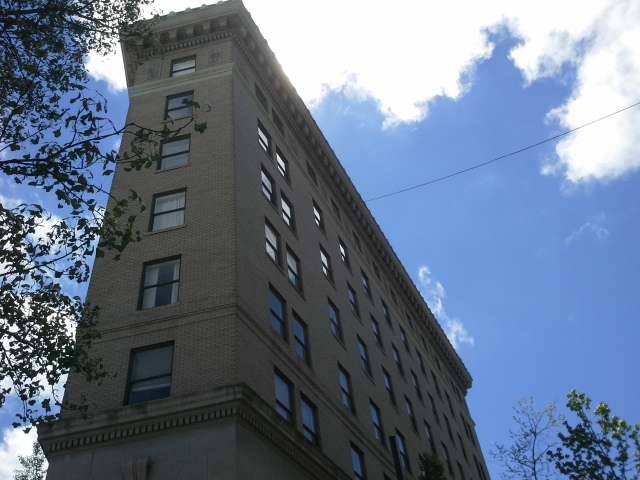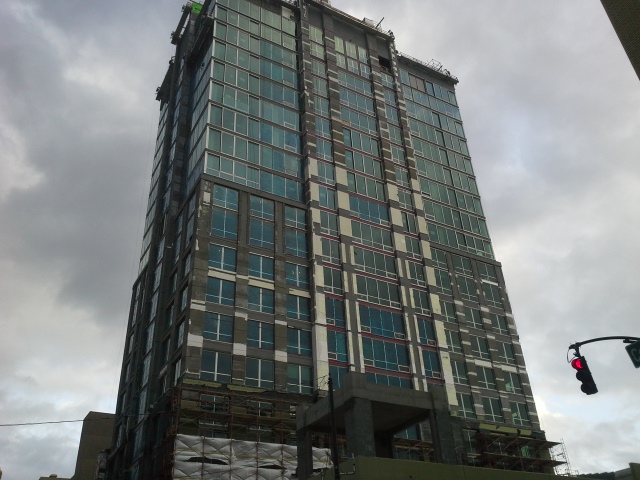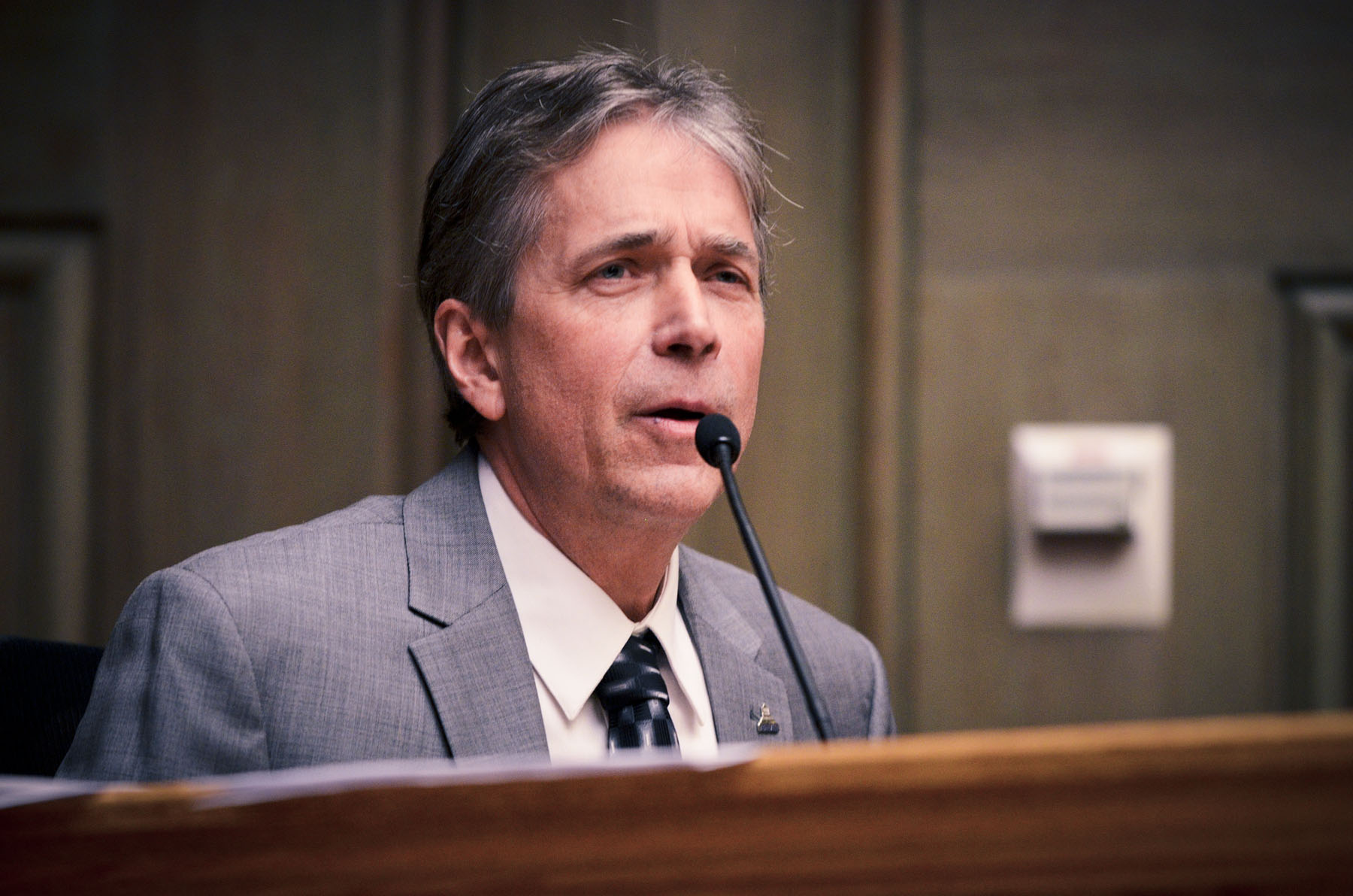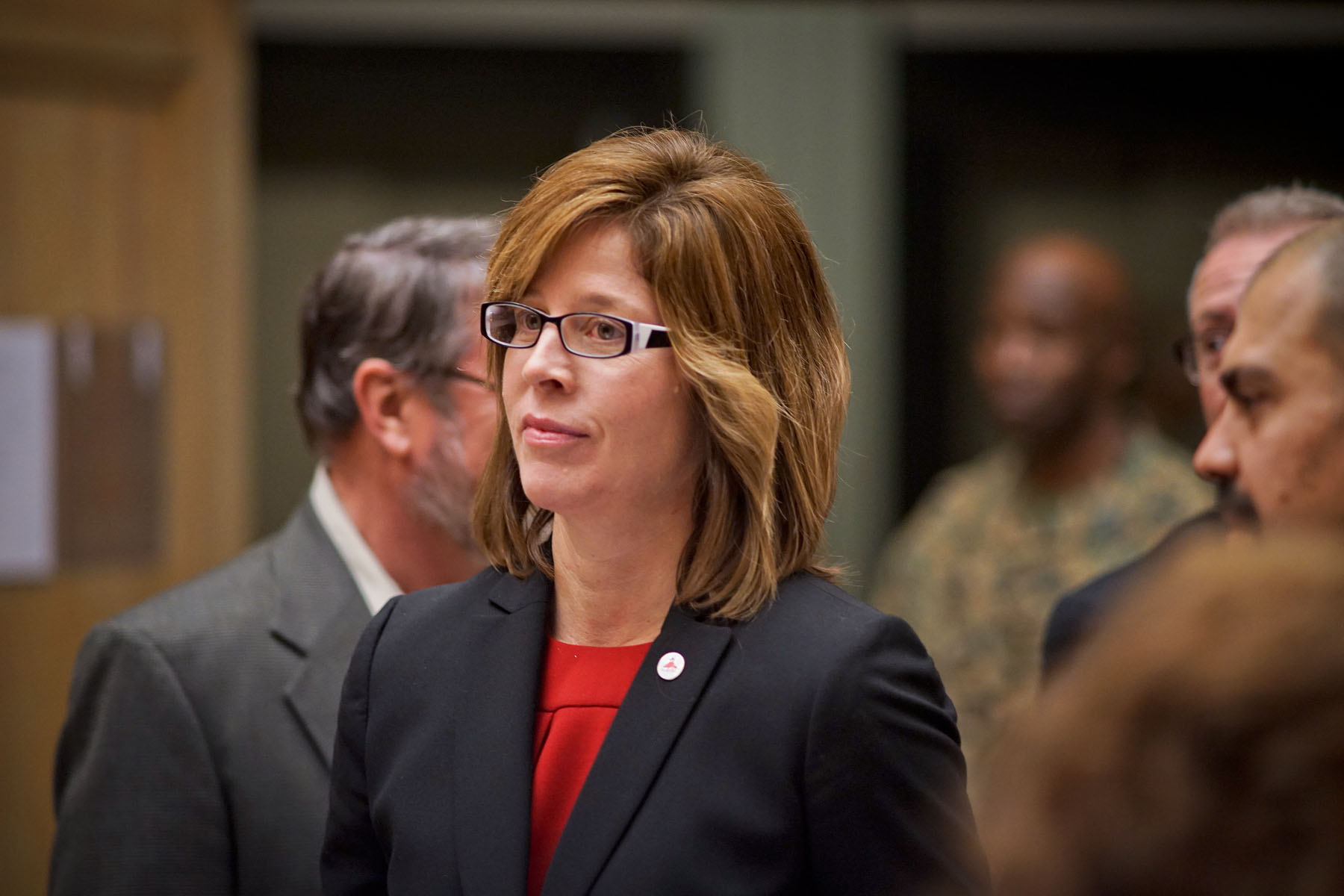


With the fight over the Flatiron looming, here’s a primer about the many battles over one of Asheville’s fastest-growing and most hated industries
Above: the Flatiron building, which the owner and a hotelier are pushing to convert into a luxury hotel, kicking out the roughly 70 businesses and organizations currently using the space. The site is directly across from two other hotels
[Editor’s note: On April 23, less than an hour before the Asheville City Council meeting was set to begin, the developers of the Flatiron hotel project requested that the Council vote on their proposal be delayed to the May 14 meeting. To avoid confusion the piece has been updated to reflect this — D.F.]
There is, yet again, a major fight over (another) hotel. At the May 14 Asheville City Council meeting (5 p.m. on the second floor of City Hall), they’ll decide whether to allow the Flatiron building — site of roughly 70 local businesses and organizations — to become a luxury hotel.
While hotels have been a controversial issue for a long, long time, this battle is particularly important. Flatiron owner Russell Thomas and hotelier Phillip Woollcott are pushing the project as the only way to preserve the historic structure. But very few locals are buying it, and the proposal’s seen widespread opposition. After all, the landlord and hotelier stand to make millions (Thomas alone is seeking at least $16 million) on the deal, and a place full of pretty historic buildings with all the locals kicked out is closer to a cemetery than a city.
The Flatiron project would oust a large number of locals from one of the last concentrations of non-gentry organizational and business space in the heart of downtown. It would go into an area indisputably saturated with hotels. Two other hotels are across the street, 10 are within a half mile. The project wouldn’t just fail to provide parking, it would take up 40-plus spaces from already-cramped city and county decks. But despite the proposal ignoring city rules like the developers were going down a bingo card, city staff are now recommending Council sign off on the move.
While the Flatiron seems to cross a number of key boundaries, earlier this month the city’s Planning and Zoning Commission voted 4-2 to move it forward. On Tuesday, May 14, Council will have the final say. A few months ago, it looked like rejection would be almost a certainty; Council had stopped approving hotels and even rejected one. But the “hotel freeze” thawed: in April Council signed off (narrowly) on two controversial projects.
Hotels have proliferated around Asheville in tandem with the increasingly brutal pace of gentrification. Even as elected officials debate the Flatiron proposal, the massive Arras hotel project (formerly the BB&T building), nears completion. The Flatiron fight is a key battle in the hotel wars, but far from the last one.
So it’s a perfect time to look at how things got this way, why the hotel industry metastasized so quickly, what’s behind locals’ hatred of it and how elected officials’ views have shifted back and forth.
Why so many hotels?
While Asheville’s been a tourism destination for many years, hotels popping up on seemingly every corner is a fairly recent phenomenon. It was enabled by a perfect storm of gentry cash and shockingly lax local rules.
The rules over what does or doesn’t get built are one area where local governments in North Carolina have a fair amount of power. Many locals have, with good reason, asked how our city officials allowed so many hotels so quickly.
In the mid-2000s, a political consensus emerged between several small but very influential groups. Increasingly vocal downtown gentry teamed up with senior city staff to rewrite a key part of the city’s rules. There were, at the time, a lot of Council battles over approving downtown development, and it wasn’t always predictable which way they would go.
Those two groups, along with more development-friendly “progressive” Council members, felt the process was too haphazard, arbitrary and time-consuming. They worried that needed housing and commercial space faced too many hurdles, and invoked the specter of the virtually abandoned downtown of the ’70s and ’80s. Critics of the proposal asserted that the goals were somewhat more cynical: these groups were less averse to developers getting their way and were tired of locals pushing back.
So their solution was to take power over all but the largest projects in downtown out of the hands of Council (the elected officials assented to this in a split vote in 2010). Instead the Planning and Zoning commission would make the call about much of the area’s development, according to new, ostensibly stricter guidelines.
While the new rules were supposedly intended to primarily aid housing and business development, they were overwhelmingly used by another industry. The Downtown Master Plan created (not entirely unintentionally) a perfect environment for hoteliers, and they took advantage of it aggressively. Planning and Zoning commissioners are often fairly well-off themselves, tied to the tourism boom and its profits as architects, realtors or developers. “P and Z” has always been one of the city’s more conservative boards and — as its hearings are less well-known than Council’s — more out of sight of the public eye.
As the recession wore off, hoteliers began to take more notice of Asheville. This wasn’t just an accident of geography. Asheville’s hotel tax dollars don’t go to any local government, but to the Tourism Development Authority, a powerful, hotelier-run organization that pours the cash back into marketing the area to bring even more tourism. During this time period, their marketing especially targeted the wealthy (and overwhelmingly white) customers that “upscale,” “luxury” and “boutique” hoteliers positively lust after.
A full-on bubble ensued. Over the past few years, hotels cropped up throughout the city, first in downtown and then in many other areas as well. But as public anger at the industry grew, Council members claimed they had no control. Pointing to the rules (that they had passed and could have revoked) they noted that the vast majority of the new hotels never went before them for approval.
Why do Ashevillians hate the hotel industry?
There are so, so many reasons. In a time when our city has a severe housing shortage and locals feel pushed out of more and more places, each hotel represents something far more needed that isn’t being built. The industry tends to pay poorly in a city with already-dismal wages. The rapacious greed and blatant classism that many hoteliers readily exhibit doesn’t help either.
In a particularly infamous example, gentry involved in the Parisian project wanted the county Department of Health and Human services moved away from downtown because their investors and wealthy guests didn’t want to see “undesirables.” Council actually declined to take them up on that offer.
As well as bringing in those who literally don’t want to set sight upon Ashevillians and taking up land desperately needed for other uses, the industry’s directly knocked out multiple local amenities as well. Smokey’s Tavern, a longtime LGBT bar, was driven out partly by damage done during the construction of the neighboring AC Hotel. The site is still vacant. Meanwhile 51 Grill, a popular diner for Ashevillians leaving local bars or getting off work, was outright demolished to make way for yet another hotel. The Flatiron tenants, who are facing removal from some of the only remotely affordable space left in downtown, are another example of the very real damage the industry can do to those in its way.
As a 2015 Blade column summarized, every hotel furthers the aspects of a gentrifying city locals most hate: places we can’t afford built for people who don’t live here offering jobs that pay locals badly to benefit those who, in some cases, openly want us forced out. In the four years since that hasn’t changed.
Hotels aren’t the only part of the lodging industry that’s done serious damage or attracted major pushback. Airbnbs have devoured three percent of the city’s housing supply — the highest percentage of any city in the country — and faced a similar backlash, especially as they were literally kicking locals out of their homes.
That feeling hasn’t gone away. Public anger has played a major role in recent fights over hotels and even led to some projects being delayed or withdrawn entirely. But recently a majority of Council has started signing off on hotels again, though by narrow margins.
As Council member Brian Haynes, the most consistent opponent of the industry on Council, summed up local sentiment before the last hotel vote: “they’re going to keep bringing us hotels as long as we keep approving them. Anytime we add another hotel in downtown we’re just making the [cost of living] of the city continue to rise. People are having to move out of the city on a daily basis because they can’t afford to live here and we don’t seem to be doing much to combat that.”
The recent Planning and Zoning meeting offered a harsh illustration of the source of local anger. Steven West, co-owner of the Miles building and Thomas, the Flatiron’s owner, both blatantly belittled the tenants who’ve made the building a key downtown hub for many years. West claimed the tenants “are, let’s be frank, not putting in much of an investment.” Thomas characterized the people who’ve made his lucrative living possible as those “who don’t have a lot in the game, just looking to get by.”
The truth is that frequently locals hate hoteliers because hoteliers hate them and hurt communities they care about.
What’s been the political consequences?
That anger has expressed itself everywhere from the voting booth to City Hall to service workers wearing shirts bearing the silhouette of an AK-47 with the words “Tourist Season.”
In the 2015 Council elections, two candidates more skeptical of the hotel industry (Keith Young and Brian Haynes) won seats. The third winner, Julie Mayfield, was more sympathetic to the industry but still felt the need to return a donation from hotelier John McKibbon in the wake of public anger.
One of the new Council’s first meetings, however, gave McKibbon what he wanted: the go-ahead to overhaul the BB&T building into a combination of condos and hotel rooms for the super-wealthy. Both Haynes and Young opposed the proposal. The majority of Council that supported it, however, signed off on the “McKibbon standard,” an unofficial set of conditions that would make them more likely to approve hotels in the future. Specifically, they wanted infrastructure improvements and donations to the city’s affordable housing trust fund (McKibbon chipped in $250,000). How many workers actually made a living wage was something Council generally refrained from grilling hoteliers on.

The massive Arras hotel, currently under construction. Council’s approval of the hotel set the ‘McKibbon standard’ some members use when deciding whether to approve new hotels downtown
McKibbon’s project was so huge that it actually went to Council for approval; most other hotels continued to slide in under the old rules.
In 2017, Council voted unanimously to take back power over hotels and most downtown development, reversing the consensus that had held sway for most of a decade and giving the elected officials direct power over approving any lodging 20 units or more. But it took months for the new rules to go into effect (partly because senior staff took an unusually long time rewriting them), giving a multitude of hotels a chance to file under the old rules that gave Planning and Zoning the power to approve their construction. During that time Council unanimously rejected one hotel, but had to do so under old rules that left them more vulnerable to a court challenge (which the hotelier subsequently filed and, so far, has won).
During the fight over Airbnb Council extended their authority further. Now, outside of some narrow zones near existing hotels, all new lodging built in the city of Asheville has to go directly before Council.
But while Council has retaken that authority, they’ve proven incredibly reluctant to use it. Now hoteliers would emphasize their local ties, claim they treated their workers like family (actual pay rates were, naturally, almost never mentioned) and assert that their proposal was different from the others. Generally Council’s bought it.

Council member Brian Haynes, who’s emerged as the hotel industry’s most consistent opponent in City Hall. File photo by Max Cooper
So where does Council stand on hotels? Since the current slew of elected officials took office in late 2017, hotels have been before them seven times. Four of those were approved, two were delayed (and later approved) and one was rejected outright.
Of Council’s current members, Haynes was the only one who opposed every one of those proposals.
But the rest of Council has generally signed off on them, even in the face of growing public anger. Mayor Esther Manheimer only voted against one of those hotel proposals (she opposed one of the delayed proposals the first time it came before Council, but eventually voted to support it). Council members Julie Mayfield, Vijay Kapoor, Sheneika Smith, Keith Young and Gwen Wisler have all voted against hotel proposals twice (Kapoor was absent for one hotel vote).
The individual results can be all over the map. Young was elected as a hotel skeptic and voted against McKibbon’s Arras project. But his oft-stated reluctance about the industry has mostly been voiced before he’s voted to give them the go-ahead. Wisler is one of Council’s most conservative members, and generally fairly friendly to developers. She was the sole dissenting vote for the one hotel this Council turned down, but has voted against the last two to come before Council and, in rhetoric at least, has become more skeptical of the industry. Smith was one of the most left-leaning candidates to win a local election, but in office she’s generally voted to approve hotels.
Most Council members publicly say they consider hotels on a case-by-case basis, but in almost every case their answer is “yes.”
What brought on the ‘hotel freeze?’
Public rage. Last year, a proposal to put a hotel near Lexington Avenue saw a crowd of locals show up to the initial developer meeting and denounce the proposal. The developer meeting on the Flatiron proposal also saw a crowd of angry locals show up. These meetings, the very first chance in the city’s development process for locals to publicly comment, usually see just a few property owners show up, so 50-plus angry Ashevillians turning up sent a message.
The sense, even in the depths of City Hall, was that people were rapidly losing their patience. The change was swift. On Oct. 9 of last year, Council signed off on a hotel (Mayfield and Haynes against, Kapoor absent). On Oct. 23 a proposal from the Milan Hotel group offered Council $500,000 (in five annual installments) for the affordable housing trust fund and a rebuilt playground at Lee Walker Heights if the elected officials would sign off on an extended stay hotel on Biltmore Avenue near Mission Hospitals. The elected officials balked and hotelier Monark Patel withdrew the proposal rather than having it kicked out of Council directly. Developer Albert Sneeden likewise delayed a hotel proposal (also on Biltmore Avenue) rather than face that political climate.
In early December, for the first time since Council had taken back authority over hotels, they actually rejected one outright, turning down a proposal to build a luxury hotel in the Biltmore Village area 6-1 (Wisler voted against rejecting the development).
Behind the scenes developers started re-gearing their hotel plans, delaying them or considering turning them into condos or commercial space instead. But as winter turned to spring, the freeze thawed. In April Council would approve both Patel and Sneeden’s proposals.
Why did the ‘hotel freeze’ end?
A range of reasons, if Council members are to be believed (that, reader, is up to you). Manheimer claimed that because TDA officials have now promised that they will study the impacts of tourism (and possibly, maybe, someday) redirect some of the hotel tax dollars, she’s fine with once again giving most hotels the go-ahead.

Mayor Esther Manheimer has voted to support hotels more than any other current Council member. Her shifting views on giving the industry the go-ahead have proven key in recent hotel votes. Photo by Max Cooper
Patel’s proposal hadn’t changed substantially but the politics on Council seemingly had. Patel had donated to local churches and nearby community groups, securing their support. Wisler now was more adamantly against hotels. But Smith voted in favor after pointing out that the city had done nothing when black families were pushed out of the area (which is absolutely true, but doesn’t explain suddenly supporting giving a millionaire hotelier the go-ahead). The hotel passed 4-3 (with Haynes, Young and Wisler against).
Sneeden’s proposal, like the Flatiron, seized upon historic preservation as a justification, claiming that a luxury hotel was the only way to preserve several historic houses on the site. That seemed to sway more centrist Council members (Mayfield and Kapoor specifically cited it in their votes to approve). Sneeden also touted that his company was considering building affordable housing elsewhere (which secured Young’s support). Once again, the hotel passed 4-3 (with Haynes, Smith and Wisler against).
Given that, it’s anyone’s guess how May 14 will go.
Why is the fight over the Flatiron so important?
As the above political battles show, morale is everything in politics. Haynes’ assessment is basically accurate: as long as Council keeps approving hotels, hoteliers will keep proposing them. Public rage and the perception that Council had finally turned against the industry led to many hoteliers delaying, changing or withdrawing proposals. Even though the “hotel freeze” has thawed, many are still reluctant, as the shifting of a single vote on Council could send their projects down in defeat.
The Flatiron proposal seemingly crosses every line Council holds dear. It kicks out the kind of local businesses and small non-profits they claim to love, goes into an area already saturated with hotels and violates numerous city guidelines. City rules usually require a drop-off zone for guests as well as a loading zone, this one only has a loading zone. City officials claim they’re concerned with a lack of downtown parking and require hotels to have 40-plus spaces nearby. The Flatiron proposal provides no parking and would actually take those spaces from already-full public decks.
The Flatiron is far from the end of the hotel wars, but if Council approves turning the building into a luxury hotel, they’ll sign off on anything. Hoteliers will take note and the floodgates will open, making the previous wave of hotels look mild by comparison.
Will they? As so often, that depends on how angry the public gets, and what consequences the people of Asheville are willing to inflict.
—
The Asheville Blade is entirely funded by our readers. If you like what we do, donate directly to us on Patreon or make a one-time gift to support our work. Questions? Comments? Email us.